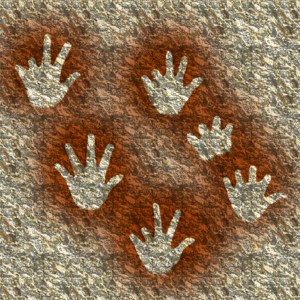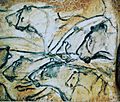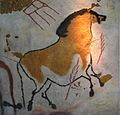Easy Cave Paintings to Draw

Easily in Gargas cave, France
Cave paintings are paintings on cave walls and ceilings. Usually these paintings were made in prehistoric times. Most cave paintings date from ten,000 to 20,000 years ago. The oldest are from near 32,000 years ago, merely scientists still disagree if this dating is correct.
It is not known why these paintings were made. Most people think they may accept had a function for rituals. They may also have been a style to transit data; to tell other people about something. Most paintings are in caves that are difficult to access. These caves unremarkably also exercise non show signs that people lived there all year circular.
Today, in that location are almost 350 caves known which take paintings in them. Many are in French republic and Espana. The best known are probably the caves of Altamira (in Spain), Lascaux (in French republic), or Creswell Crags in England. Sometimes, paintings were as well done on cliff faces. Fewer of those have survived though, because of erosion. I such example are the rock paintings of Astuvansalmi (in Finland).
Most oftentimes, animals or hunting scenes were painted. Sometimes hands are there also. Rarely, there are also more abstract patterns.
The paintings were drawn with red and yellowish ochre, hematite, manganese oxide and charcoal. Sometimes the silhouette of the animal was put into the rock starting time.
Styles
André Leroi-Gourhan (1911-1986) has classified the paintings into different styles:
| Style | Time period | Examples | Caption |
|---|---|---|---|
| I | Chatelperronien Aurignacien | Herbivore in Belcayre | Schematic paintings of animals, such equally horses and mammoths. Very often only the caput or back of the creature is shown. Lines and dots often used in improver. Verbal dating is difficult. |
| II | Gavettien, Perigoriden, Soultréen | Pair-non-Pair cave Venus of Laussel | During this time, the paintings may have first been used for rituals / religious purposes. Paintings on plates, in the entrance part of the cave, or in rock shelters. They tin be found within the cavern simply rarely. Paintings get more schematic, and the neck/dorsum of the animal is oft included in the painting. Venus figurines appear, and are all schematic: the legs/anxiety are lacking, the confront and artillery are only hinted at. Hips, belly and breasts are very pronounced. Impressions of hands are establish for the first time |
| III | Soultréen, early on Magdalenien | Lascaux Pech Merle Roc de Sers El Castillo Rocamdour | Peak of development of rock fine art. Lines are finer, and people tried to show animals in motion. Very short legs, and body, which appear too large when they are compared to the head. The marked lines of the dorsum, which are very pronounced in style 2 are less pronounced. Horns and antlers of animals are frequently shown in a perspective view. Very oftentimes, bisons and horses are painted. They are commonly shown in the same drawing. Other animals are often shown every bit extras. There are signs that almost always announced next to the animals. Humans are shown in relation to the animals, for the first time. Positive and negative imprints of hands are present. |
| IV | Magdalenien III and Iv, Magdalenien Five and VI | Trois Frères Les Combarelles | Most caves are in this style. Mobile objects appear, and allow a farther nomenclature of this way. Animals are shown in a very realistic manner. Horns and antlers are too shown realistically, and no longer in perspective view. Horses have a marked belly, and ii lines on their shoulders. Bisons have a triangle on their loins. There are different symbols side by side to the animals. |
Theories
There are dissimilar theories, what could have led people to paint in caves. The most common explanations are given below:
- It could be a form of hunting magic, which is meant to increase the number of animals. Another explanation is closely related, and was found past examining hunter-gatherer societies: These paintings were made by shamans. The shaman would retreat into the darkness of the caves, enter into a trance state, and and so paint images of their visions, perhaps with some notion of drawing power out of the cavern walls themselves.
- It could be some form of graffiti, mostly washed by adolsecent males of the time. Venus figurines which have roughly the same historic period were also found. According to this theory, there were many adolescents in the order of the time. Most of the adolescents who painted were male person, but some were female.
- The paintings may have been made for applied reasons: There is some hidden symbolism which may show the techniques of hunting, or the routes the animals took.
- People painted what they wished for or what they had dreamt of. Alternatively: these paintings were seen every bit "art" at the time. There are several societies today, who do not accept a word for art, but who practice the same painting.
Gallery
-

-

-

from Chauvet
-
-
from Niaux cave, French republic
-

A mammuth etching, from Pair-Not-Pair, France
- Stone art
- Upper Palaeolithic
Images for kids
-

-

Cueva de las Manos (Spanish for Cavern of the Easily) in the Santa Cruz province in Argentine republic
-

Cueva de las Monedas
-

Castilian cavern painting of bulls.
-
Rock paintings from the Cave of Beasts (Gilf Kebir, SW Egypt Libyan Desert).
-

Cave paintings at the Laas Geel complex in northern Somalia.
-

30,000-yr-onetime cavern hyena painting constitute in the Chauvet Cave, France
-

Polychrome cave painting of a wolf, Font-de-Gaume, France
-

All content from Kiddle encyclopedia manufactures (including the article images and facts) tin be freely used under Attribution-ShareAlike license, unless stated otherwise. Cite this article:
Cave painting Facts for Kids. Kiddle Encyclopedia.
Source: https://kids.kiddle.co/Cave_painting



0 Response to "Easy Cave Paintings to Draw"
Post a Comment